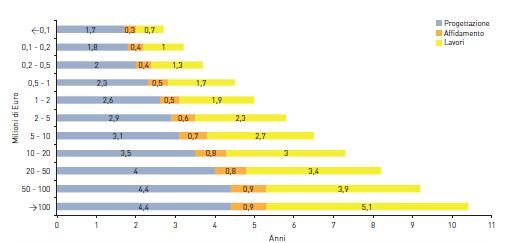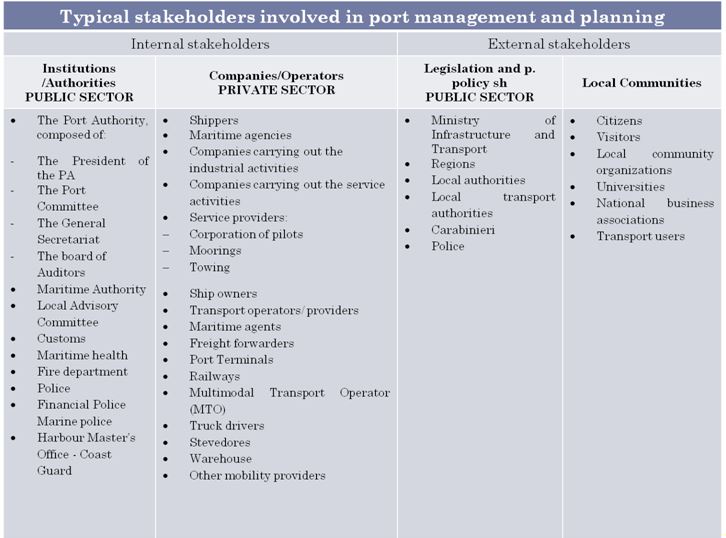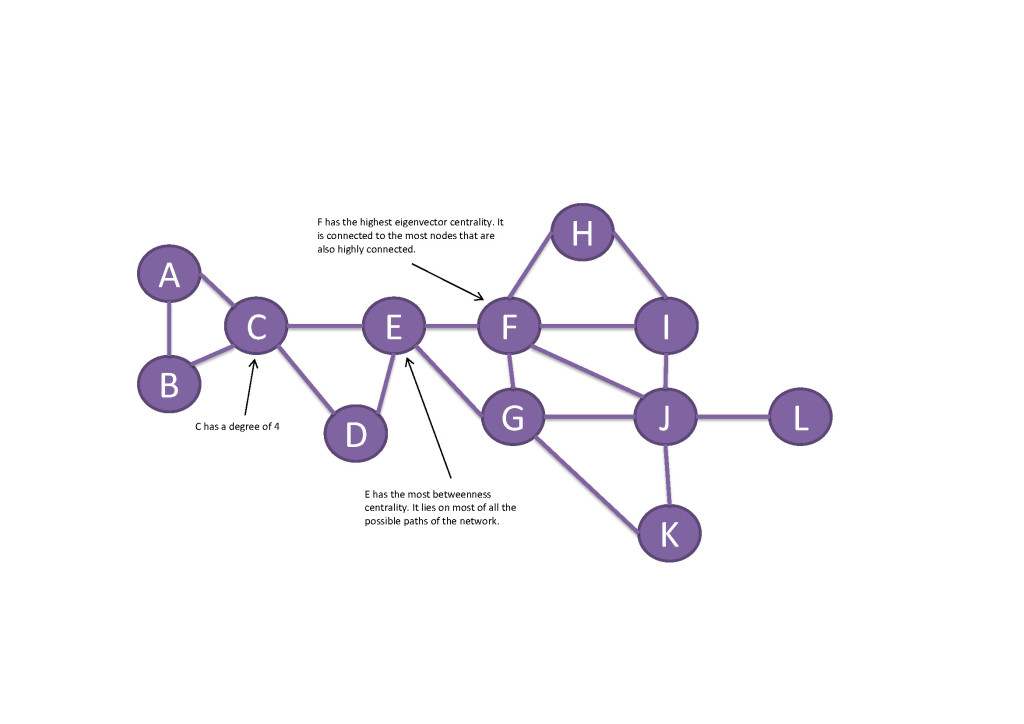Transport infrastructures are complex systems for the many actors involved, their conflicting interests and for the procedural issues, particularly when a choice has to be taken among different alternative plans or projects.
When the decision making process is not well managed, the dilation of times among the phases of planning, designing, tendering and building new transport infrastructures and systems is a main risk. In the worst case the “do-nothing” alternative may be the most probable outcome.
 Transport infrastructures construction times by cost range and implementation steps. (Source: TEH – Ambrosetti, 2012)
Transport infrastructures construction times by cost range and implementation steps. (Source: TEH – Ambrosetti, 2012)
The main decision-maker in transport planning is the Public Administration which is supposed to interpret the collective preferences of the represented community, usually assisted by expert planners. The results of the decisions, in the form of a transport plan, affect in a direct way the so-called “stakeholders” and in an indirect way the social, economic and environmental dimensions of the whole community living in the reference area.
Port Planning
In the context of maritime transports, ports play a strategic role in the development of domestic and international trade and have a strong impact on the liveability of the local community hosting the port as well.
The objectives of a port are highly dependent on the mission statement, the regional market and the institutional context. They can be very different: from maximizing throughput, to maximizing net profit, operating at least cost, reaching financial autonomy, maximizing employment, or promoting regional economic development, maximize quality of service to shippers, just to give a few examples.
Port planning is a decision-making process based on the forecasting of transport demand and supply, as shown in. It is mostly a public-oriented activity, based on the evaluation of alternative options according to different criteria (economic, financial, environmental, social, functional) and to the assessment of priorities. The long term strategic equilibrium of the port activity is largely affected by the institutional framework (Port Ownership Model), by the Stakeholder Relationship Management (SRM) able to take into proper consideration the opinion of all actors involved in the port community.
 Port planning framework. (Gaur, 2005)
Port planning framework. (Gaur, 2005)
The success of a port and its competitiveness depend largely on the way the port manager succeeds in directing the interactions between different stakeholders.
Public Participation
There can be different types of barriers to the decision-making process as described by Cascetta (2011):
-
barriers of context, which in turn can be institutional (i.e. who is responsible for what), legal (i.e. what is allowed by the law) and financial (i.e. lack of resources);
-
barriers of the decision-making process due to the traditional approach of the decision-maker DAD (Decide – Announce – Defend) and the frequent consequence of contrasting new projects, also known as NIMBY syndrome (“Not In My BackYard”), or the more extremeBANANA (“Build Absolutely Nothing Anywhere Near Anyone”).
The NIMBY syndrome is so widespread in Italy, that a web forum has been set up to monitor the phenomenon (https://www.nimbyforum.it): in 2012 more than 300 NIMBY-syndrome-affected public works which caused protests and resistance from local communities has been recorded.
Example of NIMBY syndrome: Gioia Tauro, despite the protest, the Port Committee gives go-ahead to the regasification terminal. (Source: www.contropiano.org/ambiente/item/14982)
 Example of NIMBY syndrome: Pescara, fishermen protest: “we will block the harbour with our boats”. (Source: www.ilpescara.it/cronaca/protesta-marineria-pescara-bloccheremo-il-porto-con-le-barche.html)
Example of NIMBY syndrome: Pescara, fishermen protest: “we will block the harbour with our boats”. (Source: www.ilpescara.it/cronaca/protesta-marineria-pescara-bloccheremo-il-porto-con-le-barche.html)
Though EU policy already promotes Public Participation (PP) whenever plans and programmes have an impact on the environment (Aarhus convention (1998), Directive 2003/35/EC, Agenda 21, Directive 2001/42/EC on the Strategic Evaluation Assessment), only 17% of ports involved local communities and stakeholders in port development plans (Brooke, 2002 cited in Henesey et al., 2003).
Nowadays, because of globalisation of production and consumption which induced structural changes in the inter-port/intra-port relations, the success of a port and its competitiveness depend more and more on the way the port manager succeeds in directing the interactions between different stakeholders and the concept of stakeholders has become a key term in any port management strategy (Henesey et al., 2003;Winkelmans and Notteboom, 2007). Involving all stakeholders from the beginning and during all the planning phases assures a transparent and (probably) shared decision-making process. Moreover, a greater focus on external stakeholders may increase the port activities’ legitimacy at the city and regional levels, and may also contribute to sustainable development (Dooms et al., 2004).
Public Participation (PP) is the formal procedure aimed to involve citizens and stakeholders into the decision-making process.
It should favour a shift from the traditional planning approach, where the decision-maker with the experts makes the decision and then announces (and defends) it to the community (the above-mentioned DAD), to a deliberative approach, with the engagement of the interested parties at the beginning of the process, which leads to a deliberation (and a decision) and finally to the implementation of the decision, following an approach called EDD: Engage – Deliberate – Decide (Walker, 2009).
 Shift from DAD to EDD approach. (Walker, 2009)
Shift from DAD to EDD approach. (Walker, 2009)
Taking properly into account the ‘strategic intent’ of different stakeholder categories by assuring a public participatory process, can facilitate the convergence to a shared solution, avoid waste of time and money, help the inclusion of the sustainability principles in the port mission, raise the responsibility of local communities towards projects, enlarge the coalitions on the choices, give to planners a clearer awareness of needs and constraints, help to find more effective solutions, provide a better understanding of the potentiality of the plan and its possible economic opportunities.
Building the participation process
There are different levels of participation, as stated by Arnstein (1969) in the so called “ladder of citizen participation” which shows the different types of participation and “nonparticipation” dividing them into eight different rungs. “Civil Society” and “Citizen Control” are the highest levels of involvement, where citizens are responsible for the implementation of plans. It is necessary to choose the appropriate type of involvement related to the plan and the background, avoiding the lowest levels which correspond to the “Nonparticipation”, making the participation process useless and time (and money) wasting. The “participation pyramid” is derived from the previous ladder and represents the different levels of participation (Holstein, 2010). According to Holstein choosing the appropriate level of involvement is the first step in order to “guarantee a proper connection between participation as a process, the input and proposals of all participants in this process, and the final decision stage”.
 The participation pyramid. (Holstein, 2010)
The participation pyramid. (Holstein, 2010)
Cascetta and Pagliara (2011) propose to include PP in all the basic phases of a transport planning process, according to five levels of participation:
-
stakeholder identification, at the early stage of decision-making context assessment;
-
listening, during the analysis of the present situation and the identification of plan objectives;
-
information giving and consultation, while formulating and evaluating the alternative systems’ projects;
-
participation in the final choice.
Stakeholder identification in port planning
Thanks to the specific functions that are located inside the port it is possible to identify stakeholders and categorize them according to three main categories:
-
Institutions and authorities (public sector), which in turn can be:
-
internal stakeholders
-
public policy stakeholders
-
-
Companies and operators (private sector), which can be:
-
considered as internal stakeholders
-
-
Local communities (or community stakeholders), which can be considered as external stakeholders
The categorization proposed is inspired to the four categories described in Henesey et al. (2003), where the internal stakeholders are part of the comprehensive port authority organization, while the external stakeholders are the in situ and ex situ economic players.
 Typical stakeholders involved in port management and planning.
Typical stakeholders involved in port management and planning.
Tools for the Public Participation
Traditional tools to support a participatory process are meetings, focus groups and interviews with the relevant stakeholders. They are sometimes regarded as compulsory moments of the decision-making process, time and money consuming, often depriving participation from its effectiveness. Whatever the approach chosen, it is fundamental to deliver a clear identification of the stakeholders to be involved, the role they have in the decision-making process, the nature of their relationships, building a real network, where each node is a stakeholder and each link represents the relation between two nodes. To this aim Social Network Analysis (SNA) can be used (Dempwolf and Lyles, 2010), with different techniques such as interviews with the stakeholders (Kazmierczak, 2012; Pitt, 2008) or the snowballing technique (e.g. with automated software such as StakeNet, StakeSource (Lim et al., 2011). Then adequate centrality indicators can be calculated to measure the importance of the actors in the network, to identify the stakeholders who are the most critical for an effective participatory process.
For example, in the network of image the stakeholder C has a degree centrality of 4 because it is connected to 4 nodes; the stakeholder E has a high betweenness centrality, as it lies on the paths connecting most of the nodes; at last stakeholder F has a high eigenvector centrality because it is connected to the most nodes that are also highly connected.
 Centrality indexes in a stakeholders’ network.
Centrality indexes in a stakeholders’ network.
To this network, lying in the space of stakeholders’ relationships, it is possible to associate another stakeholders’ network, in the space of opinions. This enables the interaction process to be reproduced through simulation models of the opinion dynamics on the network, able to investigate how the information exchange among stakeholders endowed with different opinions. Le Pira et al. (2013) built a multi-agent based simulation model to investigate to what extent the interaction among the stakeholders and the exchange of information can affect the majority’s opinion, as a function of the topology of the network, the initial distribution of opinions and the relative influence of stakeholders.
 Stakeholders’ network NetLogo, https://ccl.northwestern.edu/netlogo/. (Le Pira et al., 2013)
Stakeholders’ network NetLogo, https://ccl.northwestern.edu/netlogo/. (Le Pira et al., 2013)
 Opinions’ plot using NetLogo, https://ccl.northwestern.edu/netlogo/. (Le Pira et al., 2013)
Opinions’ plot using NetLogo, https://ccl.northwestern.edu/netlogo/. (Le Pira et al., 2013)
Public Participation in a Port Action Plan
The University of Catania, as partner of the PORTA project (www.porta-project.eu) supported by the European Regional Development Fund within the MED Programme, experimented the relevance of public participation of the diverse stakeholders involved in the preparation of a Port Action Plan and in particular the relationships between Port Authority and city/citizens. According to the proposed planning model, based on the Deming cycle PDCA (Plan-Do-Check-Act), a Port Action Plan should consider the community involvement in all the phases. The five levels of involvement below described can be coupled with the different phases of the PDCA cycle:
 The role of PP in the port planning process.
The role of PP in the port planning process.
Conclusions
Community Involvement can contribute substantially to the acceptance of long term strategies in port planning. It is an integral part of the plan and adequate resources have to be devoted to it. It must be performed following a procedure along the entire decision making process.
Suitable tools have to be developed to assure the decision making process will be effective, efficient, transparent and flexible.
Stakeholder network analysis and opinion dynamics modelling have proofed to be promising tools to assist who is in charge to lead the participatory process.
References
Arnstein, S R1969, ‘A ladder of Citizen Participation’, Journal of the American Planning Association, vol 35, no. 4, pp. 216–224.
Cascetta, E 2011, ‘Transportation Planning: Decision-making, Public Engagement and Systems Engineering’ SIDT, National Conference and International Seminar, Venice 2011.
<https://www.enniocascetta.net/public/20120713143507Cascetta_SIDTfinal.pdf>
Cascetta, E, Pagliara, F 2011, ‘Public Engagement and Transportation Planning: Some evidences from Italy’, SIDT, National Conference and International Seminar, Venice2011.
Dooms, M, Macharis, C, Verbeke, A 2004, ’Proactive stakeholder management in the port planning process: empirical evidence from the Port of Brussels, ERSA conference papers ersa04p271, European Regional Science Association.
Henesey, L, Notteboom, T, Davidsson, P 2003 ‘Agent-based simulation of stakeholders relations: An approach to sustainable port and terminal management’, Proceedings of the International Association of Maritime Economists Annual Conference in Busan, Korea, 2003, IAME.
Gaur, P 2005 ‘Port planning as strategic tool’, MS Thesis, University of Antwerp.
Holstein, A N 2010, Participation in climate change adaptation, EU Interreg IV C project GRaBS Expert Paper 2.
Kazmierczak, A 2012, ‘Working together? Inter-organisational cooperation on climate change adaptation’, EcoCities project, The University of Manchester, Manchester, UK.
<https://www.adaptingmanchester.co.uk/sites/default/files/EcoCitiesSNA_FINAL.pdf>
Le Pira, M, Ignaccolo M, Inturri G, Garofalo C, Pluchino A, Rapisarda A 2013, ‘Agent-based modelling of Stakeholder Interaction in Transport Decisions’, Paper presented at the World Conference on Transport Research 2013. Rio de Janeiro, Brazil
Lim, S L, Damian D, Finkelstein A, 2011, ‘StakeSource 2.0: Using Social Networks of Stakeholder to Identify and Prioritise Requirements’, in Proceedings of the 33rd ACM/IEEE International Conference on Software Engineering.
<https://soolinglim.files.wordpress.com/2010/07/stakesource2-0_icse11.pdf>
Pitt, M 2008, ‘Using Social Network Analysis to Study Participation in the Community-University Partnership Megaprojects for Communities’, Method Report CE08-02E. Montréal: CURA Making Megaprojects Work for Communities – Mégaprojects au service des communautés.
Dempwolf, S, Lyles, W 2010, ‘The Uses of Social Network Analysis in Planning: A Review of the Literature’ Journal of Planning Literature, vol. 27, no. 1, pp. 3-21.
La gestione intelligente delle infrastrutture di trasporto aereo 2012. The European House – Ambrosetti, Milano.
Walker, P 2009 ‘Dinosaur DAD and Enlightened EDD – engaging people earlier is better’ The environmentalist, vol. 71.
Winkelmans, W, Notteboom, T 2007, ‘Port master planning: Balancing stakeholders’ interests’, in K Dobrowolski & J Zurek (eds), The reality and dilemmas of globalization, The Foundation of the Development of Gdansk University, Gdansk.
